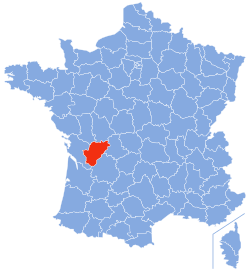Charentes
| Charente | |||
|---|---|---|---|
| Department | |||

Prefecture building of the Charente department, in Angoulême
|
|||
|
|||
 Location of Charente in France |
|||
| Coordinates: 45°50′N 0°20′E / 45.833°N 0.333°ECoordinates: 45°50′N 0°20′E / 45.833°N 0.333°E | |||
| Country | France | ||
| Region | Nouvelle-Aquitaine | ||
| Prefecture | Angoulême | ||
| Subprefectures |
Cognac Confolens |
||
| Government | |||
| • President of the General Council | Michel Boutant (PS) | ||
| Area | |||
| • Total | 5,956 km2 (2,300 sq mi) | ||
| Population (2013) | |||
| • Total | 353,482 | ||
| • Rank | 67th | ||
| • Density | 59/km2 (150/sq mi) | ||
| Time zone | CET (UTC+1) | ||
| • Summer (DST) | CEST (UTC+2) | ||
| Department number | 16 | ||
| Arrondissements | 3 | ||
| Cantons | 19 | ||
| Communes | 394 | ||
| ^1 French Land Register data, which exclude estuaries, and lakes, ponds, and glaciers larger than 1 km2 | |||
Charente (French pronunciation: [ʃa.ʁɑ̃t], Saintongeais: Chérente, Occitan: Charanta) is a department in southwestern France, in the Nouvelle-Aquitaine region, named after the Charente River, the most important river in the department, and also the river beside which the department's two largest towns, Angoulême and Cognac, are sited.
Charente is one of the original 83 departments created during the French Revolution on 4 March 1790. It was created from the former province of Angoumois, west and south of Saintonge.
Prior to the creation of the department, the area was not a natural unit, but much of it was commercially prosperous thanks to traditional industries such as salt and cognac production. Although the river Charente became silted up and was unnavigable for much of the twentieth century, in the eighteenth century it provided important links with coastal shipping routes both for traditional businesses and for newly evolving ones such as paper goods and iron smelting.
The accelerating pace of industrial and commercial development during the first half of the nineteenth century led to a period of prosperity, and the department's population peaked in 1851. During the second half of the nineteenth century Charente, like many of France's rural departments, experienced a declining population as the economic prospects available in the cities and in France's overseas empire attracted the working age generations away. Economic ruin came to many in the Charentais wine industry with the arrival in 1872 of phylloxera.
During the twentieth century, the department with its traditional industries was adversely impacted by two major world wars and even in the second half of the century experienced relatively low growth, the overall population remaining remarkably stable at around 340,000 through the second half of the twentieth century, although industrial and commercial developments in the conurbation surrounding Angoulême have added some 10,000 to the overall population during the first decade of the twenty-first century.
...
Wikipedia


